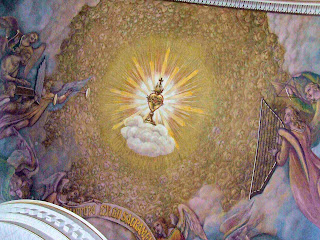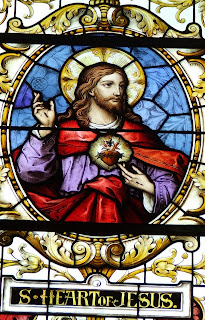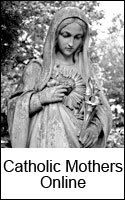 Heart of Jesus. Finished in 1787, the building itself is the oldest Catholic stone church in the U.S. and is the oldest stone church of any denomination in use in our country. Originally the parish, founded by Jesuits in 1741 was dedicated to St. Mary of the Assumption, but from the beginning was called Conewago Chapel. In fact, the local population often still refers to the Basilica by that name. We hard nosed Germans don't give up on much.
Heart of Jesus. Finished in 1787, the building itself is the oldest Catholic stone church in the U.S. and is the oldest stone church of any denomination in use in our country. Originally the parish, founded by Jesuits in 1741 was dedicated to St. Mary of the Assumption, but from the beginning was called Conewago Chapel. In fact, the local population often still refers to the Basilica by that name. We hard nosed Germans don't give up on much. In that this church existed before the Church in America officially existed, the parish originally was under the authority of the Bishop of London.
In that this church existed before the Church in America officially existed, the parish originally was under the authority of the Bishop of London.  August of the following year.
August of the following year. In April of 1808 Philadelphia became a diocese. At that time the diocese's territory was defined
 as all of Pennsylvania and Delaware, plus portions of New Jersey. Due to a delay caused by political unrest in Europe at the time, the official paperwork directing that Franciscan Fr. Michael Egan was to be the first to ascend to the Philadelphia bishopric did not reach Baltimore's Bishop Carroll until 1810. In the interim Fr. Egan served from Philadelphia as Bishop Carroll's vicar-general.
as all of Pennsylvania and Delaware, plus portions of New Jersey. Due to a delay caused by political unrest in Europe at the time, the official paperwork directing that Franciscan Fr. Michael Egan was to be the first to ascend to the Philadelphia bishopric did not reach Baltimore's Bishop Carroll until 1810. In the interim Fr. Egan served from Philadelphia as Bishop Carroll's vicar-general.
Bishop Nicholas C. Dattilo
 As you approach the basilica, the spire captures your attention. It draws eyes skyward. Sitting high upon a hill, once eyes are drawn upward, there is nothing else to see besides the heavens.
As you approach the basilica, the spire captures your attention. It draws eyes skyward. Sitting high upon a hill, once eyes are drawn upward, there is nothing else to see besides the heavens.
 There is one other angel stained glass window at the basilica, but it is one that could easily be missed for it is on the side at the top of one of the staircases leading to the choir loft.
There is one other angel stained glass window at the basilica, but it is one that could easily be missed for it is on the side at the top of one of the staircases leading to the choir loft. 
 The Gabriel and Rose of Lima windows are part of a series of windows of the saints, along with an image of the Sacred Heart of Jesus, that are on each side of the church apse.
The Gabriel and Rose of Lima windows are part of a series of windows of the saints, along with an image of the Sacred Heart of Jesus, that are on each side of the church apse.As the windows of Rose of Lima and the Archangel Gabriel are at the choir loft level, so too are those of the other saint windows. Beneath each is found another stained glass window.
These lower windows illustrate important biblical moments. Jesus Found in the Temple
Jesus Found in the Temple
And he said to them, "Why were you looking for me? Did you not know that I must be about my Father's work." (Luke 2:49)
...behold, the angel of the Lord appeared to Joseph in a dream and said, "Rise, take the child and his mother, flee to Egypt, and stay there until I tell you. Herod is going to search for the child to destroy him."
Joseph rose and took the child and his mother by night and departed for Egypt. (Luke 2:13-14)
"Now, Master, you may let your servant go in peace, according to your word,
for my eyes have seen your salvation,which you prepared in sight of all the peoples,
a light for revelation to the Gentiles, and glory for your people Israel." (Luke 2:27-32)
 The Nativity
The NativityThen he took a cup, gave thanks, and gave it to them, and they all drank from it.
He said to them,
 The Ascension of Jesus
The Ascension of Jesus Descent of the Holy Spirit
Descent of the Holy SpiritThen there appeared to them tongues as of fire, which parted and came to rest on each one of them. And they were all filled with the holy Spirit (Acts 2:1-4)
 Jesus Buried in the Tomb
Jesus Buried in the TombAfter this, Joseph of Arimathea, secretly a disciple of Jesus for fear of the Jews, asked Pilate if he could remove the body of Jesus. And Pilate permitted it. So he came and took his body.
Nicodemus, the one who had first come to him at night, also came bringing a mixture of myrrh and aloes weighing about one hundred pounds.
 Sermon on the Mount
Sermon on the MountWhen He saw the crowds, He went up the mountain, and after He had sat down, His disciples came to Him.
He began to teach them, saying:
"Blessed are the poor in spirit, for theirs is the kingdom of heaven.
Blessed are they who mourn, for they will be comforted.
Blessed are the meek, for they will inherit the land.
Blessed are they who hunger and thirst for righteousness, for they will be satisfied.
Blessed are the merciful, for they will be shown mercy.
Blessed are the clean of heart, for they will see God.
Blessed are the peacemakers, for they will be called children of God.
Blessed are they who are persecuted for the sake of righteousness, for theirs is the kingdom of heaven.
Blessed are you when they insult you and persecute you and utter every kind of evil against you (falsely) because of me.
Rejoice and be glad, for your reward will be great in heaven. Thus they persecuted the prophets who were before you." (Matthew 5:1-12)
 The Wedding in Caan
The Wedding in CaanHis mother said to the servers, "Do whatever he tells you." (John 2:5)
In the narthex of the basilica is a stained glass window of the Holy Family.

Individual stained glass portraits of the Blessed Mother and St. Joseph are in the church itself, seperate from the collection of saints - yet at the same level.
This iconographic image of the Virgin Mary is located across from a Marian altar. Beneath it, immediately above the doors, is a stained glass window of colorful design.

The window between the St. Joseph's stained glass portrait and the doors on the other side of the church is relatively similar. 
In keeping with the traditional balance found in most Catholic churches, one might imagine that the St. Joseph window would be facing a St. Joseph altar, but that is not the case. Instead, the other side altar is a St. Francis Xavier altar.
On each side of the painting of Our Lady's Assumption, which is placed on the left side of the main altar, are the statues of two Jesuit saints. Their relics rest below. The Sacred Heart above.

 St. Aloysius Gonzaga, who died as a fourth year Jesuit seminarian, is the patron of Catholic youth.
St. Aloysius Gonzaga, who died as a fourth year Jesuit seminarian, is the patron of Catholic youth.
A former military man, St. Ignatius Loyola, founder of the Society of Jesus, is the patron saint of soldiers.
On the other side of the main altar, across from the stained glass image of St. Joseph, is the painting "Dying of St. Francis Xavier." This painting is also surrounded by statues of luminaries of the Society of Jesus. The Sacred Heart is above.


There is a reliquary of each on the side altar.
From the picture below an idea of the positioning of the statues with relation to the portaits and main altar may be ascertained. The photograph was taken when a pilgrim image of Our Lady of Guadelupe visited the basilica in April of 2005. It is the pilgrim image that is in the center of the aisle, near the communion rail..JPG)

 Devotion to the Sacred Heart of Jesus did not begin with St. Margaret Mary. It could be said that St. John the Evangelist resting his head on the Sacred Heart during the Last Supper was the beginning of the gradual advancement of the devotion.
Devotion to the Sacred Heart of Jesus did not begin with St. Margaret Mary. It could be said that St. John the Evangelist resting his head on the Sacred Heart during the Last Supper was the beginning of the gradual advancement of the devotion.
Of the timing of His apparitions to her, Jesus told St. Margaret Mary, "My divine Heart is so inflamed with love for mankind ... that it can no longer contain within itself the flames of its burning charity and must spread them abroad by your means."
The ceiling directly above the main altar is a chalice like representation of the Sacred Heart.
The Sacred Heart of Jesus devotion was approved by Pope Clement XIII in 1765 with the purpose that it would "renew the memory of that divine love."
Pius IX instituted the Feast of the Sacred Heart of Jesus in 1856
The transept ceiling is adorned with three Trinitarian frescos 


All three of the paintings not only feature the Father Son and Holy Spirit, but also contain adoring angels.
At each corner of the central apse painting is a portrait of a Gospel author.
Between the Evangelists is a grant depiction of the Assumption of the Blessed Virgin Mary into Heaven.
This picture shows the positioning of Luke and John with relation to the Assumption. Though you cannot see them, Matthew is opposite of Luke and Mark is opposes John.
One might assume that there is an incredible amount of molding in the basilica, but that isn't the case. Most of what seems to be molding is actually skillfully executed trompe l'oeil.
All of the statues in the basilica are located in the transept, save one of the Sacred Heart that is in the rear of the church. That statue rests above the main entrance from the vestibule.
On the right side of the rear of the church is an entrance to a side room which was once used as a library. It has since been converted to Our Lady's Chapel. Although it is a functional chapel, Our Lady's Chapel also serves as a museum of sorts in that it contains three relics and in that pictures of Sacred Heart's history line its side walls. Below are but three of the many pictures
Although it is a functional chapel, Our Lady's Chapel also serves as a museum of sorts in that it contains three relics and in that pictures of Sacred Heart's history line its side walls. Below are but three of the many pictures
The first shows the church decorated in a manner radically different from the present. The differences are so thorough that even the communion railing is different. The current dual gates bears the Twin Hearts - the Sacred Heart of Jesus and the Immaculate Heart of Mary - and the railing itself is simpler, no angels. The pews remain the same.
The second photo shows progression toward the present appearance. Gone is the Last Supper mural. In its place it the current painting. Two items that may not be immediately recognizable in the picture, but that are interesting features are:
The gas light that is suspended from the ceiling that is slightly off center, toward the bottom
The picture that is hanging on the far left is one of the old stations of the cross paintings. In that the present stations were erected in 1901, this picture must have been taken before then

The last one shown here is from the 1950's. For the most part, it is close in appearance to the present church. It seems that, if in addition to moving the Sacred Heart statue and the Papal umbrella, you added the present altar, you could take the same picture today. At the rear of Our Lady's Chapel is hung one of the hand painted stations of the cross that used to be in the main church. All of the stations are still held by the basilica, but this is the only one accessible to the public.
At the rear of Our Lady's Chapel is hung one of the hand painted stations of the cross that used to be in the main church. All of the stations are still held by the basilica, but this is the only one accessible to the public. Mentioning that there are stations of the cross paintings that aren't readily available for public viewing reminded me of a picture that I didn't want to forget to share with you.
Mentioning that there are stations of the cross paintings that aren't readily available for public viewing reminded me of a picture that I didn't want to forget to share with you.
It is hung in the sacristy. I find this Madonna and child to be somewhat entrancing. The fanciful side of me imagines it to be like a semi-private gift from Our Lady to her son's priest that he see such a lovely image everyday. I hope it reminds him that as she was always there for Jesus, she is always there for him. 
If you ever make a pilgrimage to the Basilica of the Sacred Heart of Jesus, after you've soaked in its splendor, rested your soul, refreshed your spirit and offered a prayer of thanksgiving, please be sure to look up before you go through the last door.


It is there that you'll see this final image of the Sacred Heart in stained glass. As you go beneath it, consider offering the ejaculation, "Sacred Heart of Jesus, I trust in you."
 Sacred Heart Basilica, 30 Basilica Drive, Hanover, PA 17331-8924, (717) 637-2721
Sacred Heart Basilica, 30 Basilica Drive, Hanover, PA 17331-8924, (717) 637-2721
Entered on the National Register of Historic Places January 29, 1975, the basilica also has shrine status with the Catholic Church. It is open to visitors from dusk to dawn. Click on the final exterior picture of the basilica to be redirected to the diocesan web site's listing of Sacred Heart's Masses.
Pius XI: [Sacred Heart devotion] "leads our minds to know Christ the Lord intimately and more effectively turns our hearts to love Him more ardently and to imitate Him more perfectly."
Be aware that my pictures do not do justice to this gorgeous church. Even if I had better equipment and the best lighting, I don't think it is possible to capture its beauty. Once you've been there, you'll know what I mean.


























.JPG)


















3 comments:
Oooooh....just stunning, magnificient, worthy of His honor.
I particularly love the statue of St. Anthony (his face is so beautiful, probably because he is stareing at Jesus)
Thanks for all the time spent in doing this.
This is a work of art Mary. You are truly blessed with a gift!!!!
Gina Elizabeth O.C.D.S
Hi Micki!!!
Mary, this is beautiful! Thanks for telling me.
Post a Comment